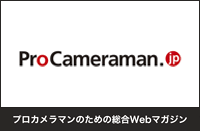◆フランス

 
▲Arigato Sugimoto-San, Calais, France, 1998(クリックで拡大)
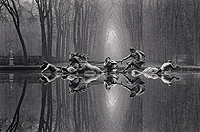 
▲Chariot of Apollo, Study 1, Versailles, France, 1988(クリックで拡大)
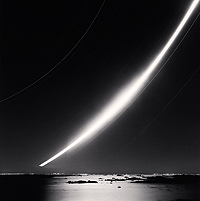 
▲Full Moonrise, Chausey Islands, France, 2007(クリックで拡大)
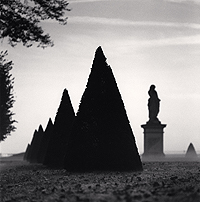 
▲Ground Mist, St. Germain-En-Laye, France, 1996(クリックで拡大)
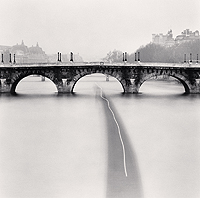 
▲Passing Barge, Paris, France, 1988(クリックで拡大)
◆イギリス

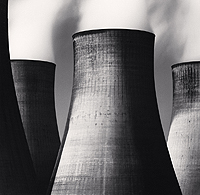 
▲Ratcliffe Power Station, Study 46, Nottinghamshire, England, 2003(クリックで拡大)
◆アメリカ

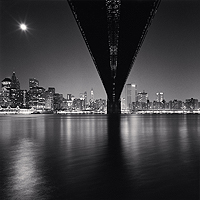 
▲Brooklyn Bridge, Study 2, New York, USA, 2006(クリックで拡大)
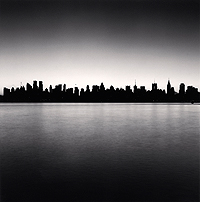 
▲Manhattan Skyline, Study 1, New York, New York, USA, 2006(クリックで拡大)
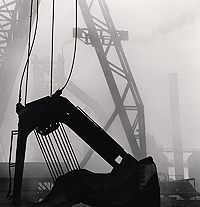 
▲The Rouge, Study 5, Dearborn, Michigan, USA, 1992(クリックで拡大)
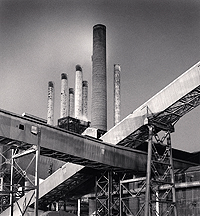 
▲The Rouge, Study 52, Dearborn, Michigan, USA, 1994(クリックで拡大)
◆中国

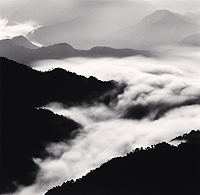 
▲Huangshan Mountains, Study 40, Anhui, China, 2010(クリックで拡大)
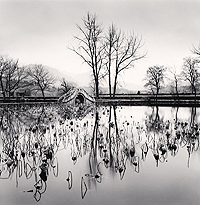 
▲Lake Bridge, Hongkun, Anhui, China, 2008(クリックで拡大)
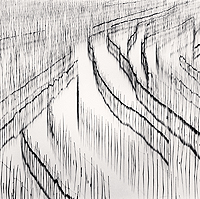 
▲Seaweed Farms, Study 3, Xiapu, China, 2010(クリックで拡大)
◆韓国

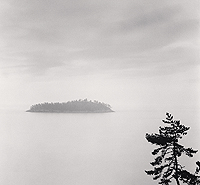 
▲Morning Calm, Jeung-do, Shinan, South Korea, 2012(クリックで拡大)
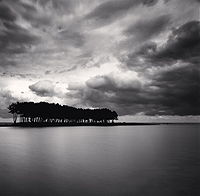 
▲Pine Trees, Study 2, Wolcheon, Gangwondo, South Korea, 2010(クリックで拡大)
◆日本

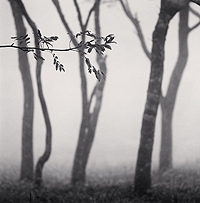 
▲Chikui Cape Trees, Muroran, Hokkaido, Japan, 2002(クリックで拡大)
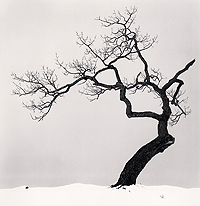 
▲Kussharo Lake Tree, Study 1, Kotan, Hokkaido, Japan, 2002(クリックで拡大)
|
|
●Biography バイオグラフィー
Q:あなたの経歴について伺います。あなたは1953年イギリス生まれですね。
Michael(以下M):はい。イギリス北西部です。私は地元のカトリックスクールに11歳まで通い、その後カトリック神父になるために継続して7年間Upholland Collegeにて学びました。けれど、何年間かUpholland Collegeで学んだ後、司祭職は私にとってはあまりよいアイデアではないと気がつきました。代わりに、美術を勉強するためにOxfordshireにあるBanbury School of Artに通いました。その後、写真を勉強するために、London College of Printing に3年間通いました。
Q:写真を撮り始めたきっかけはなんですか?
M:私が一番最初に真剣に写真を撮り始めたのは、Banbury School of Artに在学中の頃でした。それ以前に神父になるためにUphollandで勉強をしていた時、そこには進路指導がありませんでした。
私はドローイングやスケッチが上手かったのです。クリエイティブな表現の方が、サイエンスや数学などのテクニカル的なものより興味がありました。なので、1年間の美術の学校に行くことに決めました。そこで私は絵画、彫刻、編み物、金属工芸、写真やグラフィックなどのいろいろな表現手段に触れました。そして、美術への情熱を追求しながら、同時に商業取引ができ経済的にも生き延びることのできる写真が私にとって理想的な表現方法だと思いました。私は、あまりお金のない労働者クラスの家族に育ちましたので、経済的な安全なサポートはなく、キャリアが必要と感じました。どうにか自分の人生を生き抜くための道が必要でした。写真がそれを成すには一番の道と考えたのです。だから、写真を専攻することに決め、広告写真の学校に通いました。
私の作品がギャラリーに受け入れられたのはそれから何年か経った後でした。そもそも、私は広告の写真家でもあり、アシスタントでもあったのです。他の写真家のためにカラーとモノクロのラボでプリントをする仕事もしました。私は得られる広告の仕事ならなんでもやりました。生きていくために必要だったからね!
Q:映画や音楽など、若い頃に観たもので現在あなたの創作に影響している作品などはありますか?
M:私は、文化的な芸術背景がある環境で育ちませんでした。父は大工でした。兄弟全員、学校を早い時期に辞め、家族を支えるためにエンジニアになりました。私以外の家族は全員現実的なんです! 私だけが15歳を過ぎても学校で学ぶ機会がありました。
私の兄妹はみんな15歳になってすぐに家族のために働きはじめました。一番末っ子だった私は、さらなる教育を受けられる機会があり、とても幸運だったと思います。また、神学校にいることによりあまり外のメディアに触れることがありませんでした。外の世界は存在しないと同然でした。ニュースで何が起こっているかも知りませんでした。そして、美術の学校へ行ったとき、私の人生は変わりました。私は、ターナー、ピカソやカンディンスキーなどの画家に魅了されました。本格的な風景写真家たちは、写真の学校に行ってから2、3年後まで関心を持ちませんでした。そして、私はビル・ブラント、アンセル・アダムス、ヨセフ・スーデックやアルフレッド・スティーグリッツなどの写真家の作品に触れ、Wow ! この人たちはどこから来たんだ!!って思いました(笑)。。
Q:なぜアメリカに住むことを選んだのですか?
M:私の母国イギリスはとても素晴らしい場所ですが、1970年代、1980年代はアーティストとして生き残ることはできませんでした。多分、広告写真家としてならできたでしょう。しかし、実質的、写真ギャラリーは存在しませんでした。私が最初にアメリカに行ったとき、イギリスでは選択肢にはなかった、写真家がプリントを売って生活できることに気がつきました。アメリカで仕事を探し、私を扱ってくれるギャラリーが見つかり、そしてアメリカで結婚したのです! だから、私はアメリカにとどまりました。
私のルーツへの想いは年月をかけて強く、深くなりました。ヨーロッパに戻ることはとても大きいことですが、私は一度も戻りませんでした。私はそのままアメリカで暮らしました。現在、40年間近くもの蓄積されたプリント、ネガや本などがあり、大きなたき火でもしない限り、もう引っ越すことはないですね。私は長い間サンフランシスコに住み、そしてオレゴン州に移りました。ようやく2007年にとても気に入っているシアトルに移り住みました。
Q:なぜ、西海岸を選んだのでしょう?
M:私は最初、ニューヨークに行きました。とても素晴らしい場所です。最終的に西海岸になったのは、友人たちがいたからです。彼らが、私のコンタクトになり、コネクションになり、コネクションが仕事につながり、仕事と一緒に家族ができた。ほかの場所に移るより、1つの場所にとどまる方が楽だからね。西海岸はとても素晴らしい場所で、よくジョークを言うのですが、国際空港が近くにさえあれば、私は満足だよってね。
●Work 活動内容
Q:あなたはイギリス、日本、フランス、中国などさまざまな国を撮影しています。現在アメリカにお住まいですが、アメリカを撮った作品が少ないようです。何か理由があるのでしょうか?
M:私の作品にも、いくつかアメリカで撮影したプロジェクトがあります。ミシガン州にあるThe Rouge製鉄所は数年間に渡り撮影しました。私が昔住んでいたサンフランシスコでは、娘が通っていたモニーク幼稚園を撮影しました。Golden Gate Bridge、Elkhorn Slough、カルフォルニア州の南にあるMoss Landing周辺も撮影しました。また、大規模なニューヨークシティのシリーズもあります。これらは私のホームページのイメッジアーカイブの「USA、New York」で閲覧することができます。
私は本来ヨーロッパ人です。そこから私は来て、私のルーツです。だから、初期の頃の私は、継続してヨーロッパに写真を撮りにいきました。私はもうそこには実際に住んでいないので、新鮮な目で物事を観ることができたと思います。
日々の日常生活の流れで、私は自分の周囲を撮影するのはとても難しいことと感じます。いろんなことが常に起こっていて、撮影を邪魔されるのはとても簡単なことです。集中して取り組むには、時間と忍耐が必要ですが、私の家の環境では、日常的にそれは困難なのです。プリントはしなければいけないし、請求書の支払いはあり、電話にも出なければいけないし、ベットも直さなければいけない…普通の日常です。
私が旅に出る時、自分の仕事に簡単に集中できます。私のキャリアの中で前半は、ヨーロッパにエネルギーを注ぎ、後半は、アジアにエネルギーを注ぎました。私は広範囲にわたり日本の写真を撮りました。今は中国、韓国、ベトナム、インドなどほかのアジアの国の写真を撮っています。
Q:人物の写真はありませんね?
M:まったく撮りません。私は、人が存在しない場所で、人が存在したという記憶、何を残していったのかを撮ることを選んでいます。舞台のステージに例えると、私はキャラクターが舞台にあがる前と去った後を好んで撮影しています。それらの場面は、空気の中に特別な雰囲気があります。私たちの想像の中で自分たちだけの物語を誰もいないステージの上で作ることができます。けれど、キャラクターが登場した途端に、私たちは彼らのストーリーに巻き込まれます。それはまた、私の作品とは異なる経験です。
Q:あなたは時々10時間も露光すると聞きましたが本当ですか?
M:時々ね。それは私が何を撮影しているかで変わります。カメラはただのツールでしかありません。時々何か分からないものを撮影したい時があります。例えば、水の上のウェーブの代わりに、スムーズな霞んだ水面が欲しいとしましょう…それは長時間露光によって得られます。特定の雲の形が欲しかった場合は、短い露出で動きがないように撮る。もし、私が動きや星の流れが欲しい場合は、露出をもっと長くするのです。過去の露出で、12時間までいったことはあります(笑)。
Q:長時間露光の間、何をしているのですか?
M:もし夜だったら、寝ています。だいたいの場合、カメラを三脚に立てています。そして、ベッドにいくか、車の中か芝生の上で本を読みます。何を撮影しているかによって変わってきますが。
私は月が昇り、沈んでいく跡を追うのが好きです。どこに星があるのか観察するのが好きです。何時間も何にもせずに、星を観察し、雲が動くのをみて、時間が過ぎるのを体験するというのは優雅なことです。この体験は、ほとんどの人たちはもう慣れていないかもしれません。私たちは自分たちの日々をガジェットやテクノロジーで埋めています。気分転換に何にもしないのはとても嬉しいことです。
Q:どのようにして露出を決めるのですか?
M:最終的な露出は、私の試行錯誤によって決めます。少しの間、夜間撮影を行うと、露出を決めるのはとても簡単になってきます。私は同じフィルムとカメラを何回も何回も使っているので、一貫性があります。 難しいことではないです。
●Tools 現在の道具
Q:フィルムは何を使用されていますか?。
M:私はモノクロのフィルムを使っています。ほとんど、Kodakの「Tri-X 400ASA」を使用しています。このフィルムの良いところは、私が40年前に写真を始めた頃と大して変わっていないことです。旧友みたいな感じです。自由で融通が利き、使いやすい。だからまだ使っています。国によって、どんなフィルムが手に入るかによって他のフィルムも使いますが、Tri-Xは昔から私が準備をするフィルムです。
Q:撮影には何台カメラを持って行きますか?。
M:私はバックパックを持って行きます、と言えばもういくつ私が担げるか分かってしまうね。私は普段アシスタントがいないので、写真を撮るのに必要な機材は私が担ぐことができると断言できます(笑)。バックパックに入るのは、中判カメラ2台、フィルムバック2台、ビューファインダー2台です。1つはレンズを通して露出が測れるもので、1つは腰レベルのものです。いつも大体40mm〜250mmの5本のレンズを持っています。すべての機材はハッセルブラッドです。後、ケーブルリリース、軽量のカーボンファイバーの三脚と、たまに夜用に手持ちの露出計を持っていきます。
Q:あなたの作品はモノクロですが、カラー写真は撮りますか?
M:私個人の選択です。広告ではカラーを撮ることもあります。私は、カラー写真よりモノクロ写真の方がもっと素直でミステリアスだと思っています。それは、現実に写るものより、現実を通しての解釈だと思います。私は、見ているものを説明しコピーするのに興味はありません。私に興味があるのは、その被写体とコラボレーションすることです。カラー写真を観ても、私にはあまり魅力的に思えません。私は従来の暗室で自分でネガからプリントするので、モノクロだと自分で作業ができます。私はモノクロの表現手段が私のクリエイティビティに不可欠だと年月を重ねるにつれて見つけました。
Q:今あなたはハッセルブラッドをご利用ですが、1970年代は8×10のカメラを使用したと聞きました。
M:私は写真の学校で、35mm、120、4×5と8×10の使い方を教わりました。各フォーマットにはそれぞれの目的があります。しかし、私自身熱心に8×10を使用したことはありません。ほとんどの場合、1980年代半ばまで35mmを使用し、その後120に変更しました。私が広告のスタジオでアシスタントをしていた時、4×5も8×10も商品撮影のために使用しました。でも、私にとっては少し扱いにくいです。私の作品にとって必要である十分な順応性がないからです。それに、難しいし、長い距離を携帯するのには重たい! 私は1980年代半ばから、ほとんどハッセルブラッドのみを使用しています。
Q:今でも広告のお仕事をしていますか?
M:近年のほとんどの広告写真は、他の国や都市のクリエイティブディレクターに瞬時に伝えることができるので、瞬間的な結果を必要とし、デジタルフォーマットで撮影されています。私はまだデジタルでは撮りません。なので、もうコマーシャルの仕事はあまりありません。ですが、来週ボルドーでDomaine Barons de Rothschild(ワイナリー)の撮影を行います。とても楽しみにしています。
私のホームページに長年撮影してきたクライアントの作品が掲載されています。たくさんのクルマの会社の撮影をしました。これらはいつも興味深いです。
Q:何年か先、もうフィルムが手に入らなくなるかもしれません。
M:それが起こったときは何とかします。私は自分にとっての健康の方が、変化する写真のテクノロジーを追いかけることよりもっと重要だと考えています。それが現実なのです。そして、もし私がデジタルを学ばなければいけなくなっても、できるし、やるでしょう。
Q:その予感を感じていますか?
M:だんだん、アナログやシルバーの材料を見つけるのは難しくなってきています。フィルムや紙の種類も減っています。薬品もだんだんなくなってきています。
Q:それらの材料をストックしていますか?
M:私は何年分ものセピアトナーをストックしています(笑)。ただそれ以外には何もストックはしていません。私は恐れながら人生を生きるのは好きではないです。何千ものプリントしていないネガがあるので、きっとある時点で、それは暗室でプリントするより、スキャンしなければいけないかもしれません。それまでは、私が何年もやってきて、よく知っていて、満足な方法を選びます。他の人がやっているからと言って、私が変わらなければいけない必要性もなければ望んでもいません。
Q:暗室では、どのくらいのサイズでプリントしますか?
M:すべての私のプリントはセピア調色のシルバープリントで(デジタルではない)、従来の暗室でネガから45エディション4アーティストプルーフをプリントしています。私のプリントサイズはだいたい7と3/4インチ(約20センチ)の正方形で、プリントは白のミュージーアムボード(4 ply backing, 2 ply matt)16x20インチのマットボードにドライマウントしてあります。
このプレゼンテーションにバリエーションはありません。私はこれを長い間行っています。小さいサイズや大きいサイズにも挑戦しましたが、私自身このサイズが最適なサイズだと決めました。私の写真はとても深遠です。それは誰を驚かせたり、畏敬させたいためにあるわけではないのです。私は、見る人たちが私のプリントの近くにいてもらいたいのです。
Q:もし、あなたが大きなスペースで展覧会を開くことがあるとしても、あなたは同じサイズでプリントしますか?
M:はい。
Q:ギャラリーがもっと大きくプリントして欲しいと頼んでも、あなたはプリントしない。
M:しません。私は同じプリントを作ります(笑)。
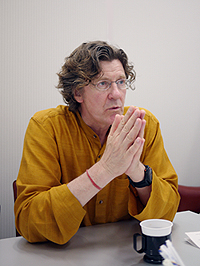
●Schedule 今後の活動
Q:現在、興味を持っているものやテーマはありますか?
M:私のテーマはあまり変わりませんが、私が撮影してきた国は変わります。私が興味を持っているのは、関係性、並列、風景と、私たち人間がその風景に残す形との相互関係です。物語、足跡、証拠、痕跡、雰囲気や歴史…これが私がいつもそこに戻る理由です。もし、私が一般で言う大自然を撮影したとしていても、だいたいそこにはその風景が変化したり、私たちが介入したことで変化したヒントや気配があります。
大げさに言うと、私が夜中に原子力発電所を撮影しているとします。これは、原発は自然とは言えません。しかし、原発と自然の間にはなんらかの関係性があり、そこに私は魅かれます。作品は、もちろん地理や主題によっても変わってきますが。
今回、2012年6月に東京・銀座のBLDギャラリーで開催した展覧会は”In France”というタイトルです。いくつかの作品は2011年に撮影しましたし、いくつかは35年前に撮影しました。さまざまな作品が1つの国で創られたものです。
現在、私は日本、中国と韓国で主に撮影をしています。作品は違った特色を持っていますが、特徴はそんなに変わりません。写真家が題材に出会ったときにコラボレーションが始まり、会話が始まります。必然的に自分の特徴やビジョンを持ち続けますが、必然的に被写体からの特徴を取り入れます。写真は多少変わりますが、同時に同じ人が撮影したことが明らかです。私は毎年変わりませんし、違うプロジェクトに挑戦もしません。私はとても忍耐力がある写真家です。私は写真家としてのキャリアを通して同じプロジェクトやテーマを撮り続けているような気がします。これが、私の人生の仕事ということじゃないかな。
Q:今回はフランスを選びました。これには何か理由がありましたか?
M:いろいろな理由があり、違うテーマや場所がめぐってくる。今回は悲しい理由で訪れました。20年以上私だけを扱ってくれたエージェントのMartine d’Arcが突然悲劇的に亡くなったのです。この展覧会は、彼女へのオマージュとして出版された“In France”をベースにしています。
これらは、自分のアーカイブから写真を選び、新しいネガからプリントをすることだけの問題でした。もちろん、私はまだフランスを撮影していますし、これからも継続して撮影し続けるでしょう。しかし、そこは私にとって今は違う場所です。フランスと北海道の2つの場所は私が残りの人生ずっと写真を撮ることができると思います。過去をみると、これらの場所に私は何度も何度も戻り続けています。だから、展覧会をするのも、本を作るのも、私にとっては大して難しいことではなかったのです。とても満足しています。
Q:北海道のシリーズについてですが、あなたが一番最初に訪ねるきっかけになったのは?
M:展覧会のために1980年代半ばに日本を訪れるようになり、私は京都、東京や他の交通の便が良い町を撮影していました。いつか田舎へ旅をして、まだ見ぬ日本の暮らしなどを見てみたかったのです。2000年にその機会が訪れ、日本を旅し始めました。それから毎年日本を訪れるようになりました。最初は本州、九州、四国、北海道など日本のいろいろな場所へ行きました。沖縄も行きました。
そして、2002年の冬に北海道を訪ねました。それは素晴らしかった。そこはまったく違う土地でした。ワンダーランド。抽象的でした。私は、北海道に継続して戻るようになったのです。それは情熱になり、その土地と恋愛関係になりました。1回その方向に進み始めたら、私は続けます。今は、もう親友に会うみたいです。もっと戻って、いろいろな会話をしたいし、討論をしたいと思う。時間が過ぎるにつれて、写真は少なくなり、私が愛する場所での面識のある木、土地、場所との再会を確かめることが増えました。しばらくしてからは、カメラのことはあまり重要でなくなったのです。
Q:年内に展覧会の予定はありますか?
M:8月まで撮影をしています。2011年に再婚をしたので、妻と彼女の小さい2人の子供がシアトルに来て一緒に住みます。なので、みんなのためにも自宅にしばらくとどまります。つまり、暗室にいっぱいいるということだね! ここ数年、旅行をして撮影をノンストップでしてきたので、プリントをスタートする時期です。結果をみるのをとても楽しみにしています。7月はフランスと韓国で撮影をするつもりです。そして、私のカメラはしばらくクローゼットの中にとどまることになるでしょう!
Q:あなたのお気に入りの日本の写真家たちはいますか?
M:はい、たくさんいます。森山大道。彼はある意味、私のお気に入りです。何故なら、彼の作品は私の作品とは真逆にあるからです。私は、自分とは違う視点の作品に魅かれます。杉本博司は多分自分の視点に一番近い日本人の写真家で、彼の作品も大好きです。彼の作品は、私にとても影響を与えたと思います。また、柴田敏雄、畠山直哉、細江英公も好きです。他にもたくさんいます。本当は、名前を挙げるのは、優遇しているみたいでいやなんです。あまり選ぶのは好きではない。日本の写真界はとても豊な文化を持っていると思います。
Q:日本の写真家たちにメッセージを頂けますか?
M:もしあなたが芸術の世界にいたり、専門的な仕事についているのなら、意志の強さと、規律、忍耐と根気が必要です。そして、膨大な幸運も必要です。私は、謙虚でいることは良いことだと思っています。1つひとつのチャンスに感謝し、できるだけいつでも流れに添っていくのがいいと思います。自分をただ信じて。すべての人がユニークであるから、あなたもユニークだと信じて。自分のユニークさは自分で探さなければいけない。他の人をまねしようとし始めた時、少し失敗します。何が起こっても、自分の内面にある声と想像力、自分を信じ続けなければいけない。他の人が何をやっていたとしても、どうにかして、自分の中の創造性とつながらなければいけない。その創造性についていけばいい。それがあなたをどこへ招くかみてみればいい。あなたにとっての目的地を信じること。うらやましがったり、他の人の人生を生きる必要はない。あなたの人生は大切です。あなたの運命を過小評価しないように。
Q:近年、広告写真界は急速に変化をしています。ファインアートの写真界も同じように変化していると思いますか?
M:ファインアートの写真界は少しファッション業界に似ていてるような気がします。私が理解するには、といっても少しですが、現在のスタイルの傾向は、大きくて、デジタルファイルで、完全に完璧な無数のピクセルの画像です。私が他へ向いている間に、写真が違う生き物へと変化してしまいました。
写真の持っている強みの1つは、現在とのつながりです(でした)。もうそれは存在しないと思います。プリントにあることをなんにも信用することはできません。私は、負け惜しみでも、文句を言っているわけではなく、ただコメントをしているのです。これが、クリエイティビティが不規則で予測できずに進展し変化していくということで、とても刺激的です。だけど、私はその道にはそっていません。私が若い写真家だったら、多分、もう少し何が起こっているか、感じていたでしょう。けど、もはやそうではありません。実際は何が起こっているか、意識しすぎて、今を追い、自分を忘れてしまいやすくなる危険性があると私は思います。最終的に、他が何をやっているか意識するのは良いことですが、あなたが選んだ道を行く強さを持っていることは良いことです。
Q:先ほど、韓国にこれから行くとおっしゃっていましたが、これは新しいプロジェクトですか?
M:私は2005年から韓国を撮り続けています。なので、これは継続しているプロジェクトだと思っています。韓国の中の特定の場所に魅かれていて、その1つが南西にある群島、シナンという場所です。私はそこの島々や、漁業を探訪しています。海苔と塩がそこの大きな漁業です。潮の満ち引きにより残される形が、ものすごく興味をそそられます。日本を探訪したように長年繰り返し訪問し、風景、産業、お寺、海岸地帯、時折冬のように寒い状況などの写真が蓄積されています。
Q:今後、新しく撮影する場所を発見すると思いますか?
M:そこの角に何があるのかまったく分からない。だから、人生がとても興味深いのです。私の中で、どうしても行きたい特定の場所はないですが、機会があればいつでも私は行きますよ。
−−ありがとうございました。
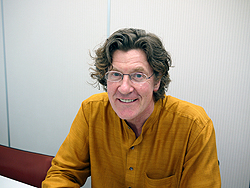
Profile:
Born 1953 in Lancashire, England. He studied photography at London College of Printing in London, England. Even though he started off his career as a commercial photographer, he followed his passion for his personal work and then moved to United States in the late seventies. He has had shows in Africa, Asia, Australia, Europe, North America and South America. He also has photographs included in the collections of the National Gallery of Art in Washinton, D.C., Victoria and Albert Museum in London, and many others. He has photographed for 40 years, and has had over fifty published books and monographs.
Q. In your works, you have photographed many countries such as England, Japan, France, and China. We don’t see you photographing in U.S. even though you reside in U.S. Is there any reason for that?
If you look at my work, there are number of projects from the USA. I photographed The Rouge steel plant in Michigan for a number of years. There is Monique’s Kindergarten, my daughter’s school in San Francisco, where I used to live. I also photographed the Golden Gate Bridge and the Elkhorn Slough and Moss Landing areas. There is also an extended series on New York City, which you can view on my website under Image Archive, USA, New York. Generally though, I am European in nature. That is where I come from and where my roots are. So, at the beginning of my career I would continually return to Europe to photograph. I think I was able to see it with fresh eyes, because I wasn’t actually living there anymore. Sometimes I find it is difficult to photograph what’s surrounding me because of the logistics of daily life. There are so many things going on all the time, it is easy to be continuously distracted. For concentration and focus, you really need time and patience. In my home environment it is sometimes difficult just because of normal everyday activities: I need to print, pay the bills, answer the phone, make the bed….normal life. When I go away for periods of time, I can more easily focus on what I am doing. As the first part of my career, my energy was towards Europe. It seems that in the second half, my energy is towards Asia. I have photographed extensively in Japan, and now I am working in China, Korea, Vietnam, India, and other Asian countries.
Q. Do you take pictures of people?
No, I don’t very much. I choose to photograph the absence of people, the memory of their presence, the traces of what’s left behind. I often use the analogy of a theatre stage. I prefer to photograph the stage before the characters appear, and after they leave. At those times, there is a certain atmosphere of anticipation in the air. We can live in our imagination and our own stories on the empty stage, but as soon as the characters arrive, we begin to be caught up in their stories. It is a different experience.
Q. You sometimes take 10 hours to shoot. Is that true?
Sometimes. It varies. It depends on what I am photographing. The camera is just a tool. Sometimes I want something that’s non-specific. For instance, instead of waves on the water, I might want a smooth misty surface, which a long exposure would give. Sometimes I want specific clouds formations so I will use short exposures and there will be no movement. If I want movement or star trails, I will extend the exposure. Some of the exposures, have gone up to ten or twelve hours.
Q. What do you do during the long exposures?
I sleep if it’s at night. I often put out cameras on tripods. Then, I go to bed or I read in the car or on the grass. It’s depends on what I am photographing.
I like to track full moon rises and full moon sets…. I like to see where the stars are. It is a luxury to do nothing for a number of hours, to watch the stars and clouds move, to experience time passing. It is an experience most of us are no longer used to. We fill our days up with gadgets and technology. I’m happy to do nothing for a change.
Q. How do you determine the exposure?
Initial exposures were based on trial and error. Once you’ve done night photography for awhile though it becomes quite easy to work out the exposures. I use the same film and cameras over and over so there is some consistency. It is not so difficult.
Q. What kind of film do you use?
I use B & W film. For the most part, I use Kodak Tri-X. 400asa film . One of the nice things about this film is that it hasn’t changed much since I first started 40 years ago. It’s like an old friend; It’s flexible and forgiving, and easy to work with. That’s why I still use it. I also use other films depending on which country I am in and where I can buy the films. Tri-X is my old stand by.
Q. When you go on a photo shoot, how many cameras do you take?
I have a backpack and that determines how many cameras I carry. I insist that I can carry what I use to photograph as I don’t usually have an assistant. The backpack can hold two 120 camera bodies, two film backs, and two viewfinders. One is metered through the lens and the other one is a waist level. I usually have five lenses with me ranging from 40mm to 250mm. All the equipment is Hasselblad. I also carry cable releases, a lightweight carbon fiber tripod, and sometimes a hand held light meter for the night. That’s about it.
Q. You mainly shoot B&W. No color photographs?
I photograph with B&W for myself. Occasionally I use color for commercial work.
Q. Why?
It is a personal decision. I find B & W to be more malleable and mysterious than color; it is more an interpretation of reality than a reflection of reality. I am not interested in describing and copying what I see. I am interested in a collaboration with the subject matter. Color for me is too specific. We see everything in color all the time. I look at color photographs and they don’t appeal to me. I also print the negatives myself in a traditional darkroom, so I can work with an image when it’s B & W. I have found the B&W medium to be an integral part of my creativity over the years.
Q. Now you use Hasselblad, but I’ve heard you used 8x10 in 70’s.
When I went to photography school, I was taught to use 35mm, 120, 4x5 and 8x10, because each format was useful for different purposes. But I’ve don’t use 8x10 for myself. For the most part, I used 35mm up until the mid-80’s, and then I switched to 120 When I assisted in an advertising studio, I used both 4x5 and 8x10 for product photography, but for me it was just too cumbersome. It doesn’t have the amount of flexibility I need for my work. It is also difficult and heavy to carry a long way! I have pretty much exclusively used Hasselblad equipment since the mid-80’s.
Q. I am going to ask about you. You were born in 1953 in England?
Yes. Northwest England. I went to a local catholic school until I was 11 and continued on to Upholland College for 7 years, where I was training to be a catholic priest. However, after a few years at Upholland I realized priesthood wasn’t such a good idea for me. Instead, I went on to study art at the Banbury School of Art in Oxfordshire. Afterwards, I went to the London College of Printing to study photography for 3 years.
Q. When did you start taking photographs?
I began my first serious photography during the years at the Banbury School of Art. Earlier, when at Upholland studying to become a priest, there was no career guidance. I just happened to be good at painting and drawing. Creative areas were more interesting for me than the technical side of things, science and mathematics So I decided to go to a one year art school where I was exposed to many different media areas such as painting, sculpture, knitting, metal work, photography, graphics, etc. Photography seemed to be an ideal media where I could both follow my passion for the arts and at the same time I could pursue a commercial trade and survive financially. I come from a poor, working class family. There was no financial safety net. I needed a career. I needed some way to make my way through life. Photography seemed to be a good way to do it. So I decided to specialize and effectively went to commercial photography school. It was a number of years later that my work was accepted by galleries. To begin with, I was very much a commercial photographer and also an assistant. I worked in color and B&W labs printing for other photographers. I did whatever commercial jobs I could get. Just a matter of financial survival!
Q. Are there any creative expressions that influenced you in your childhood such as movies, music, etc…?
I didn’t grow up in a very cultural artistic background. My father was a builder. All my brothers left school early to become engineers and support the family. They are all very practical in the family, except me! I was the only one who had the opportunity to go for school education past age 15. My brothers and sister, as soon as they became 15, went out to work and make income for the family. As the youngest, I was very fortunate to have the opportunity of further education. Also, being in the seminary school, I wasn’t exposed to a lot of media. The outside world didn’t exist very much. I wasn’t aware of what was going in the news. Then, I went to Art school and my life changed. I was fascinated with painters like Turner, Picasso and Kandinsky. I didn’t notice serious landscape photographers until two or three years into photography school. Then, I was exposed to Bill Brandt, Ansel Adams, Josef Sudek, Alfred Steiglitz and others… Wow! Where had they come from!
Q. Do you have any favorite Japanese photographers?
Yes. There are many. Daido Moriyama. He is probably my favorite in some ways. Because he is almost exactly opposite of what I do. I find that I am attracted to other viewpoints. Hiroshi Sugimoto is probably the closest Japanese photographer to my point of view, and I love his work. He has been a great influence I think. I also like Toshio Shibata and Naoya Hatakeyama. Eikoh Hosoe. There are so many. I don’t like to even mention any one because it sounds like I am picking favorites.I can’t. I don’t like doing that. Japanese photography has a very rich culture.
Q. Do you do any commercial work?
Most commercial work these days is in a digital format because people need instant results which they can flash around the world to the creative directors in other cities and countries. I don’t photograph digitally, yet. So I no longer have many commissions. However, next week I will be photographing for the Domaine Barons de Rothschild in Bordeaux, which I am greatly looking forward to. My website shows the clients I have had over the years. There have been many car companies. It’s always been interesting.
Q. Are you afraid that you might not be able to get films and chemicals in few years?
When that happens, I will deal with it. I consider my health to be far more important than the changing technology of photography. It’s just the way it is. And if I have to learn digital then surely I can and will.
Q. Do you start to feel that?
It is getting more difficult to find analog/silver materials. There are fewer choices in films and papers. Chemicals are disappearing fast.
Q. Did you stock those supplies?
I have many years supply of sepia toner… (laugh). But otherwise I don’t stockpile. When it happens, it happens. I don’t like to live life in fear. I have thousands of unprinted negatives so at a certain point I might need to be scanning them rather than printing in the darkroom. For the time being, I prefer processes that I know extremely well, am comfortable with, and I have lived with for years. I don’t need or want to change because everybody else does. That is not a good enough reason for me.
Q. What objects and themes are you interested in right now?
My themes don’t change very much, the countries where I photograph do. I am interested in the relationship, juxtaposition, and interaction between the landscape and the structures that we, humans leave on the landscape. Stories, footprints, evidence, traces, atmosphere, and history… That’s what I always return to. Even if I am photographing in what could be considered wilderness, there is usually some kind of hint and touch that this landscape has been changed or altered by our intervention. In the other extreme, I could be photographing nuclear power stations in the middle of the night. There may not seem to be a great deal of nature there, but it is still the relationship somewhere between the two that draws me. The work of course changes according to the geography as well as the subject matter. The current exhibition at the BLD Gallery in Tokyo is titled “In France”. Some of the photographs were made last year; others were made 35 years ago. It is a cross section of work made in that one country.
Now I am working in Japan, China and Korea predominantly, the work has a different flavor, but it is not totally different in character. When photographers meets their subject matter a collaboration begins, a conversation. Inevitably you retain some of your own character and your own vision, but also inevitably you take on some of the character of what you are photographing. The photographs change somewhat but at the same time it is obvious that the same person is making the photographs. I don’t change every year and try different projects. I am a very patient photographer. I feel like I have been working on the same projects and themes now for all of my photographic career. I suppose it is my life’s work.
Q. This time you chose France. Is there any reason for it?
Well, different themes and places come up for different reasons. This one came up for a sad reason. My agent in France, Martine d’Arc, who represented me exclusively for over 20 years tragically died suddenly. This exhibition is based on the publication “In France” that is an homage to her spirit. It was just a matter of going back in time and choosing images from my archive, and new negatives to print. Of course, I am still photographing France and will continue to do so, but it is a different place for me now. I would say France and Hokkaido are the two places I could photograph for the rest of my life Historically, they are the places I keep returning to over and over. So, it wasn’t so difficult for me to put together an exhibition and publication on France. It was very satisfying
Q. For Hokkaido series, what was the first reason for you to visit there?
I started coming to Japan in the mid-80’s for exhibitions and I photographed Kyoto, Tokyo, and some other accessible cities. I always wanted to travel to the countryside and see how the rest of Japan lived. In 2000, the opportunity came up and I started traveling around Japan. I have visited and photographed in Japan every year since. Initially, I went all over Japan, to Honshu, Kyushu, Shikoku, and Hokkaido. Even down to Okinawa. And then I visited Hokkaido during the winter of 2002. It was amazing. It was a whole other land. A wonderland. It was so abstract. I began to go back and kept returning. It became a passion, almost an addiction or love affair with the land. Once I started on that direction, I wanted to keep going. Now it’s like meeting a good friend. I want to keep going back, furthering the conversation and discussion. As time goes on, it gets less and less about photography, and more about renewing the acquaintance of trees, locations, and places I love to be in. The camera becomes almost irrelevant after a while.
Q. Do you have any plans for exhibitions rest of the year?
I will be photographing up until August. I remarried last year, and my wife and her two small children will come and live with me in Seattle. So, I will be homebound for a while to make everybody comfortable, which means I will also be in the darkroom a lot! I have been travelling and photographing non-stop for the past few years so it’s time to start printing. I’m looking forward to seeing the results. Next month, I will photographing in France and Korea. Then my cameras will go into the closet for some time!
Q. Why did you choose to live in U.S.?
My home country of England is a lovely place but in the seventies and eighties I could not survive being an artist there. Perhaps, I could have been a commercial photographer there. But there were no substantive photography galleries. When I first went to the states, I realized some photographers actually survive by selling prints, which wasn’t an option in England. So once I was over there I found some work, began to be represented by galleries, and then I got married! So I stayed. The roots became stronger and deeper over the years. It’s a big thing to up root everything and move back to Europe and I never quite did that. I just continued on in the States and now my business is so heavy with almost 40 years of accumulated prints, negatives, books, etc., that I doubt I will ever move ? unless I have a very large bonfire first. I lived many years in San Francisco and then moved up to Oregon. Finally in 2007 I came to Seattle which I like very much.
Q. Why did you choose the west coast?
I was in New York to begin with, which is an amazing place. I ended up on the west coast because of friends. They led to contacts and connections, and connections became employment, and employment along with family… Well, it was easier to stay in one place than to move somewhere else. The West Coast is a great place to be, and I often joke that as long as there is an international airport close by, I’m very content.
Q. Can you give us messages to Japanese young photographers?
If you are in the arts or in any professional work life, you need determination, discipline, patience and perseverance. You also need a huge amount of good luck. I think it is good to be humble. One should appreciate every opportunity and go with the flow whenever possible. Just believe in yourself. Believe that you are unique, because EVERYBODY is unique. You have to find your own uniqueness, your own self. I think we fall down a little when we imitate others. Whatever happens, you have to continue to believe in yourself, your own inner voice and vision. No matter what everybody else is doing, somehow you need to connect into your own creativity. Follow that creativity. See where it leads you. Have faith that there is a destination for you, you do not need to envy or try to live any other person’s life. Your life is precious. Don’t underestimate your destiny.
Q. Recently, the industry of commercial photography is changing very quickly. Do you find that the fine art photography is changing as well?
I suppose fine art photography is a bit like the fashion industry. From what I understand, which is little, the current style involves huge, digital files, absolutely perfect with billions pixels per image. Photography has morphed into a different creature while I have been looking the other way. One of the greatest strengths of photography is that there is/was a tie to reality. I suppose that no longer exists. We can’t really believe anything in a print anymore. And, this is not sour grapes, I’m not complaining, just commenting. It’s the way creativity moves and changes, erratically, unpredictably, and it’s exciting. But I am not really on that path. As a young photographer, perhaps, I had more of a sense of what was going on, but not anymore. Actually, I think there is a great danger of being so conscious of what’s going on that you follow the current and forget yourself. Ultimately, it’s good to be conscious of what others are doing, but also it’s good to have the strength to go your own way if you so choose.
Q. You mentioned that you are heading to Korea. Is it a new project?
I’ve been photographing in South Korea since 2005. so I would certainly consider it an ongoing project There are specific places in Korea that I am attracted to and one is called Shinan, which is an archipelago in the southwest. I am exploring the islands and the fishing industry. Seaweed and Salt are big industries there. As the tides go up and down, the structures that are left behind are absolutely fascinating. I have also been exploring in a similar way that I explored Japan with repeated visits over the years, accumulating images of the landscape, industry, temples, coastlines and occasional wintry conditions, etc.
Q. Do you think you are going to discover new spot to shoot?
I never know what is around the corner, which makes life very very interesting. I don’t have burning ambition to go any particular place, but I’m sure if the opportunity happens, I will always take it.
Q. When you are in darkroom, what’s size do you usually print?
All my prints are sepia toned silver gelatin, made by me in a traditional darkroom from negatives (i.e. non digital), in limited editions of 45 and 4 artist proofs. My print size is always about 7 3/4 inches square, and prints are dry-mounted and matted on 16 x 20 inch vertical white museum board (4 ply backing, 2 ply matt). There is no variation in this presentation. I have been doing this for a long time. I’ve experimented with smaller prints and bigger prints, but I’ve decided this is the size that I prefer, the optimum size for me. My images are quite intimate. They are not there to impress or awe people. They don’t describe details. There are there for intimate engagement. I want my viewers to be very close to the print.
Q. If you have an exhibition at a large space, do you still print your picture in that size?
Yes.
Q. Even if galleries ask you to print bigger, you wouldn’t.
No. I will make the prints exactly the same.
Thank you very much!
|
